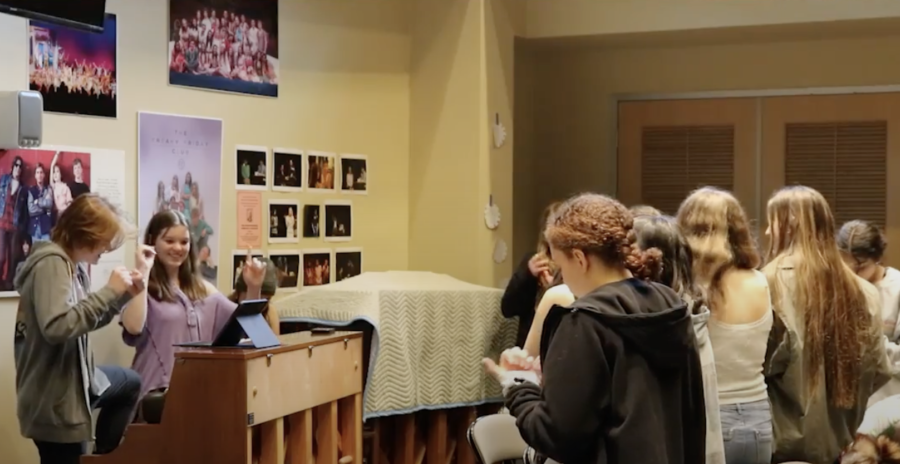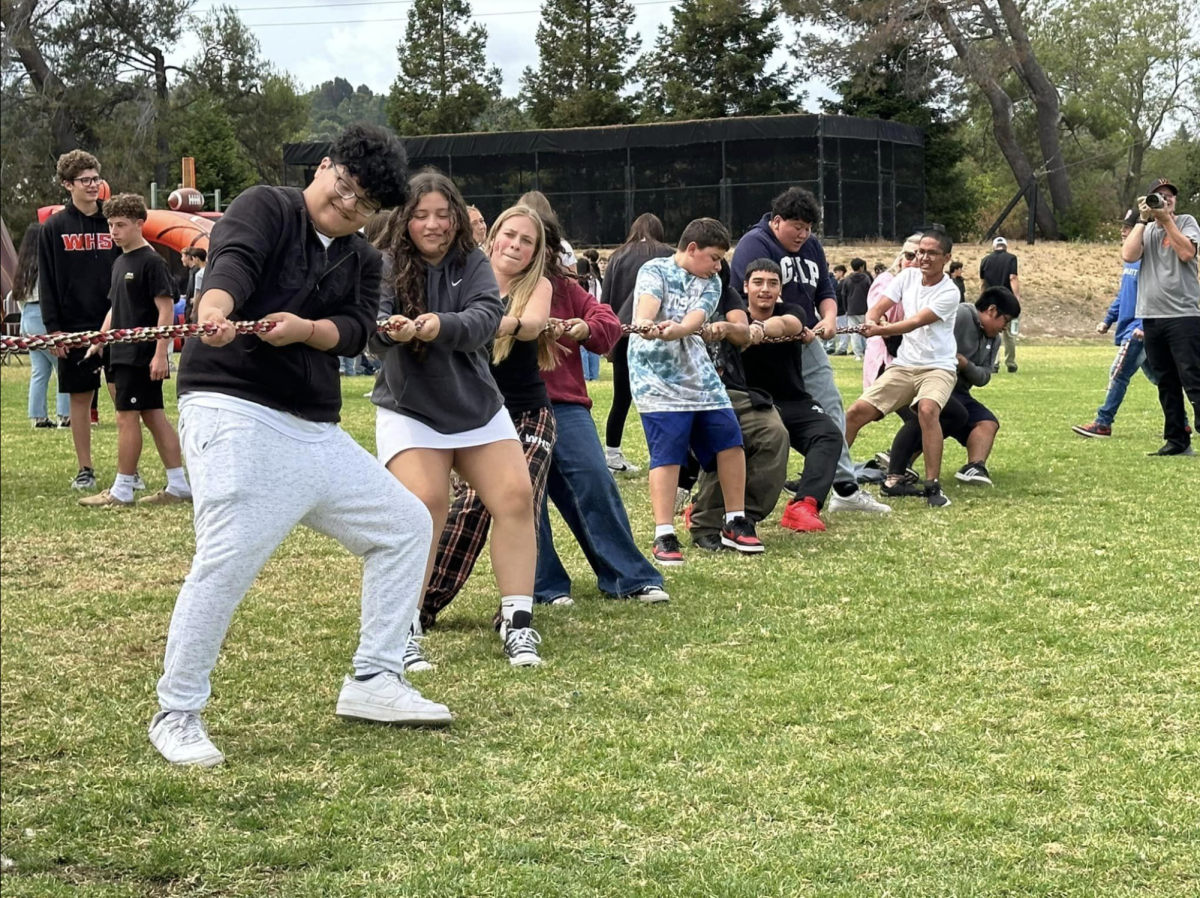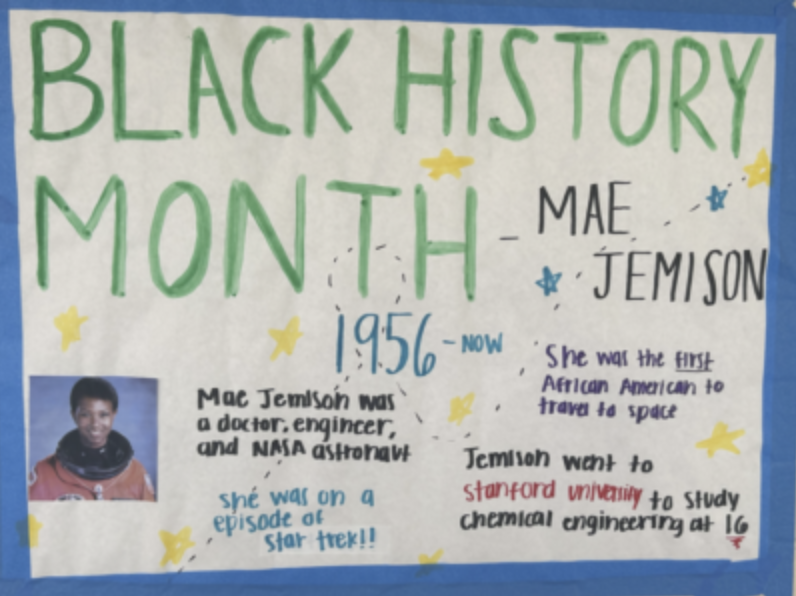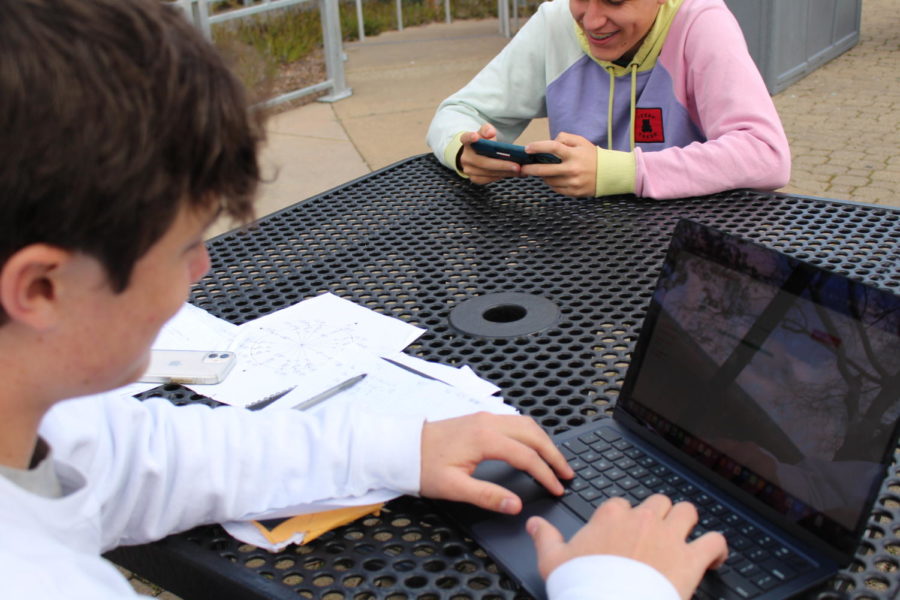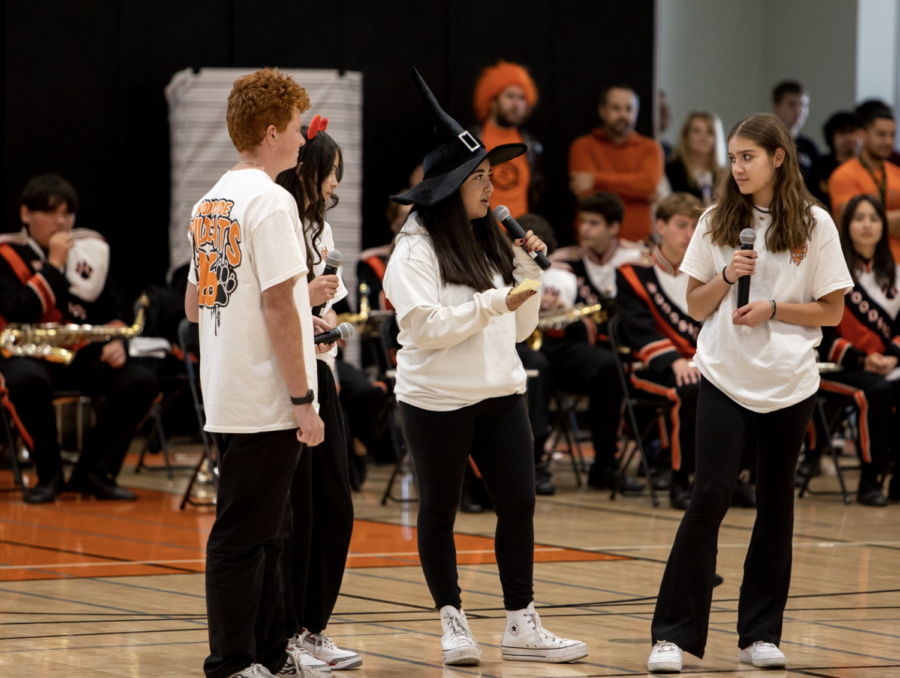From the moment the Performing Arts Center lights dim, to the impassioned applause at the final curtain call, Woodside’s spring musicals never fail to bring a show – and an audience – to life.
While the audience may find it easy to appreciate the well-polished final result of a production, it’s just as easy to forget just how much work goes into each performance behind the scenes. The arrival of “Cinderella: Enchanted Edition” on March 17 marks the date to take a look at all of the moving pieces that make these productions so memorable.
Community
After several months of singing, dancing, and acting as an ensemble, the cast inevitably grows closer together. Between the shared efforts and struggles of learning to work as an ensemble, and the group’s culture of guidance and support, newcomers and theater veterans alike find joy in becoming a part of the cast’s community.
“I’d say that there’s definitely some connection we all have,” junior Calsing Lyons, playing the King, said. “We’re all here for a reason. We all decided to come here, and we’re all good actors… I would say that we’re tight knit in the way every one of us wants to be here.”
While a supportive culture is an important part of any Woodside production, Cinderella features an especially large cast. In this larger environment, bonds often form beyond that of the entire ensemble. shared that productions like these become a great place for the cultivation of smaller, closer friendships.
“In larger shows like this one, we’re all a big community, but there are smaller groups within that,” junior Roxanne Bobo, starring as Cinderella, said. “Everybody has those friends that they already know. But yeah, it’s definitely a good community.”
Rehearsals
Cast members began rehearsals just after winter break, leaving about three months for planning, practicing, and mastering their roles. Actors with leading roles often take on the toughest responsibilities, tasked with long rehearsal hours and heavy weekly call times. Bobo rehearses five times a week for two to three hours at a time. With such demanding commitments, time management and work balance is everything.
“I’m trying to get my stuff done as soon as I get it,” Bobo said. “By the time rehearsal is over [around] 8:30, I’m honestly really tired and I just want to eat and go to sleep. So trying to get [homework] done between school and when I’m not in rehearsal, or just during tutorials… has been really helpful.”
In addition to rehearsing with the cast as a group, the effort of mastering a character often extends beyond the set and requires independent practice.
“I’d say I rehearse every single day,” Calsing Lyons said. “I might not come in [to set] every single day. But I definitely rehearse every single day for at least 30 minutes, just [to make] sure that I have it down, making sure that it’s still in my brain… a lot of it is at home, making sure that I don’t forget what I’ve already learned.”
No matter where, when, or how often cast members rehearse, every actor in the ensemble balances a vast assortment of skills. Between memorizing dance numbers, learning complex songs, and mastering the iconic Cinderella dress-change, each contributor to the spring musical has a uniquely challenging part to play.
Music and Vocals
As a defining element of any musical, the pit orchestra and cast vocals make up an important part of the production. Between vocal coaching, orchestral integration, and general musical education, the development of those signature Cinderella songs pose a substantial challenge. Following the departure of former music director Mr. Tolles, a new leader, joined the mix. Taking on his first teaching job, Nicholas Gaydos goes above and beyond to bring the musical ensemble together.
“I am the music director,” Gaydos said. “In the past, that has meant that I’m just in charge of making sure [that] all the musicians are together. But this year, I’m also the vocal coach, so I’m doing everything and anything that has to sound.”
In previous years, a separate vocal coach worked with the vocalists, as the music director focused solely on the pit orchestra. Following the vocal coach’s unavailability this year, Gaydos took on both roles, shouldering a much heavier workload than the music directors before him.
“We recently changed the way we do rehearsals just because I’m one person, [and I] can only be with them one at a time,” Gaydos said. “I have an hour and a half with just musicians alone for rehearsals, then we come together for about an hour and a half… and at the end of every rehearsal, I have about an hour of time I can use to work with the vocalists as needed.”
Vocalists come into the show from a great variety of backgrounds, with varying degrees of musical experience. Regardless of prior knowledge, Gaydos provides guidance and support for performers to put forth their best work.
“The majority of the cast does not read music,” Gaydos said. “I’ve been singing with them. I’ll mouth words for them as I’m conducting, [so] they know where to come in. And I’ll point to them, [and] give them cues.”
The employment of these teaching strategies, especially the musical recordings, make a big difference for singers.
“I actually can’t read music,” Bobo said. “That’s why I listen to the music before [performing]… You listen to the notes, and you pick that up, you get it integrated into your brain, and then you just sing it. The teaching of actually reading music isn’t really happening as much, you’re just learning how to sing.”
Dance and Choreography
As a production with a very distinct classical setting, the cultivation of similarly classical dance numbers is a crucial part of the musical. As a core element in more than one number throughout the show, Director Bary Woodruff heavily emphasizes the mastery of this classical dance.
“There’s a lot of waltzing,” Weppner said. “Through the first month or so, we’ve just been waltzing, but no choreography. As if it was a regular dance class. And then now we’ve started choreographing like what we’re actually going to do on the show.”
Costumes
In order to execute these grand ballroom scenes, the dancing itself only makes up a portion of the effort. In addition to choreographing complex waltz numbers, the cast plans to dance and perform in the correct Cinderella-esque gowns.
“We will have to dance in dresses sooner [than usual,] because that’s a big deal,” Woodruff said. “First of all, learning to dance, that’s one thing. Now, learning to dance with the dresses is a whole different thing.”
This particular production poses an uncommon need for gowns, suits, and intricate classical clothing. Most costumes are not designed on set, but instead borrowed externally.
“We have a costumer, [Karen Patrick, who] is brilliant,” Woodruff said. “She is having to bring in all these costumes, and she has to rent a lot of them, [and] she has to buy some.”
Set Design and Stage Crew
The effort to create an interesting, immersive environment is just as present behind the curtain as it is on stage. Students from the tech club come in on weekends to design and build sets we see on stage.
“The kids come in, and they get experience learning to work on sets,” Woodruff said. “They’re painting, building, [and] working on styrofoam bricks and [similar] things.”
After months of preparation, when the show finally begins, the tech crew takes charge. From scene changes, to special effects, these students work tirelessly behind the curtain to ensure a smooth performance.
“They have to run the show, so they have to know everything is choreographed backstage,” Woodruff said. “We’ll have as many as 15 [crew members] working backstage.”
While the audience will see plenty of jaw-dropping stunts on stage, there will also likely be a few thrills offered by the feats of the tech crew, both through swift transitions and clever design.
“[In] theater, you have to try to make magic,” Woodruff said. “We have to turn a pumpkin into a carriage [on stage].”
Along with these bigger stunts, Woodruff pays close attention to the small details of a scene. Especially with the “magical” aspects of the show, often, bigger endeavors are needed for the best effect.
“There are mice,” Woodruff said. “[And] There is a cat, and there’s a dove. And they change into things like horses and coachmen and things like that. We have to have puppeteers, because I don’t want life size; that would be [more like] children’s theater.”
– – –
Woodside’s “Cinderella: Enchanted Edition” is a result of months of hard work from the cast, director, set designers, pit orchestra, tech crew, and more. Ticket sales are live now, and will go toward supporting the school and theater program.
“We all came together to create this awesome production, and I really can’t wait for everyone to see it,” Calsing Lyons said.


